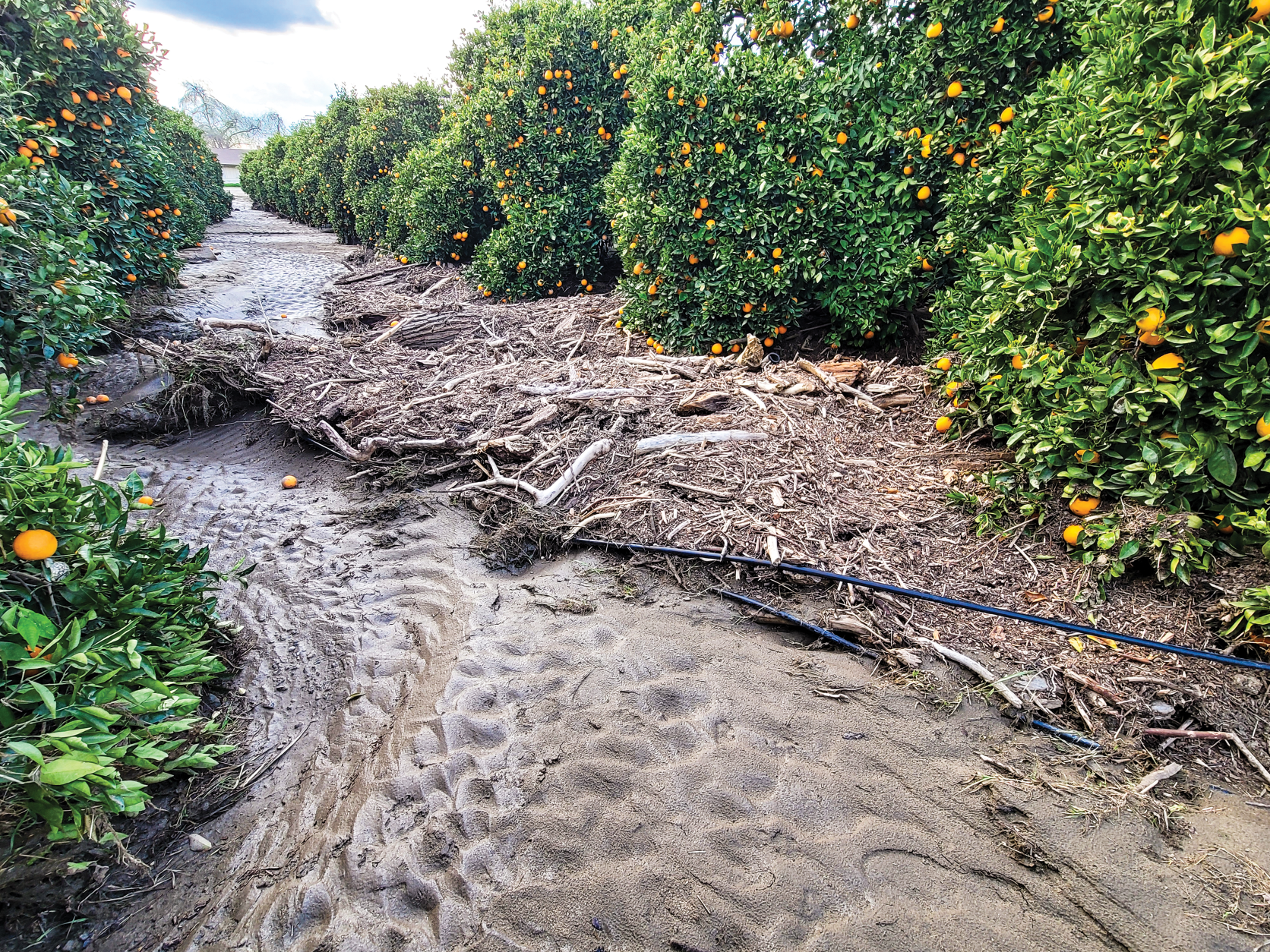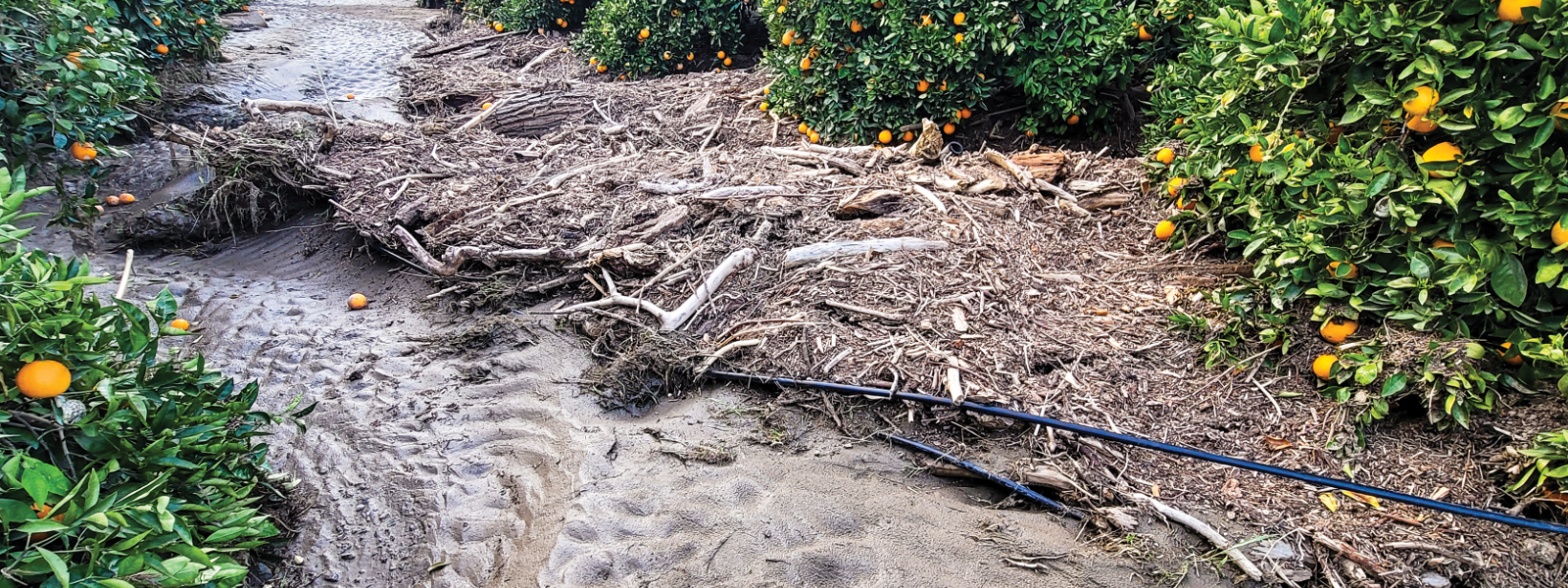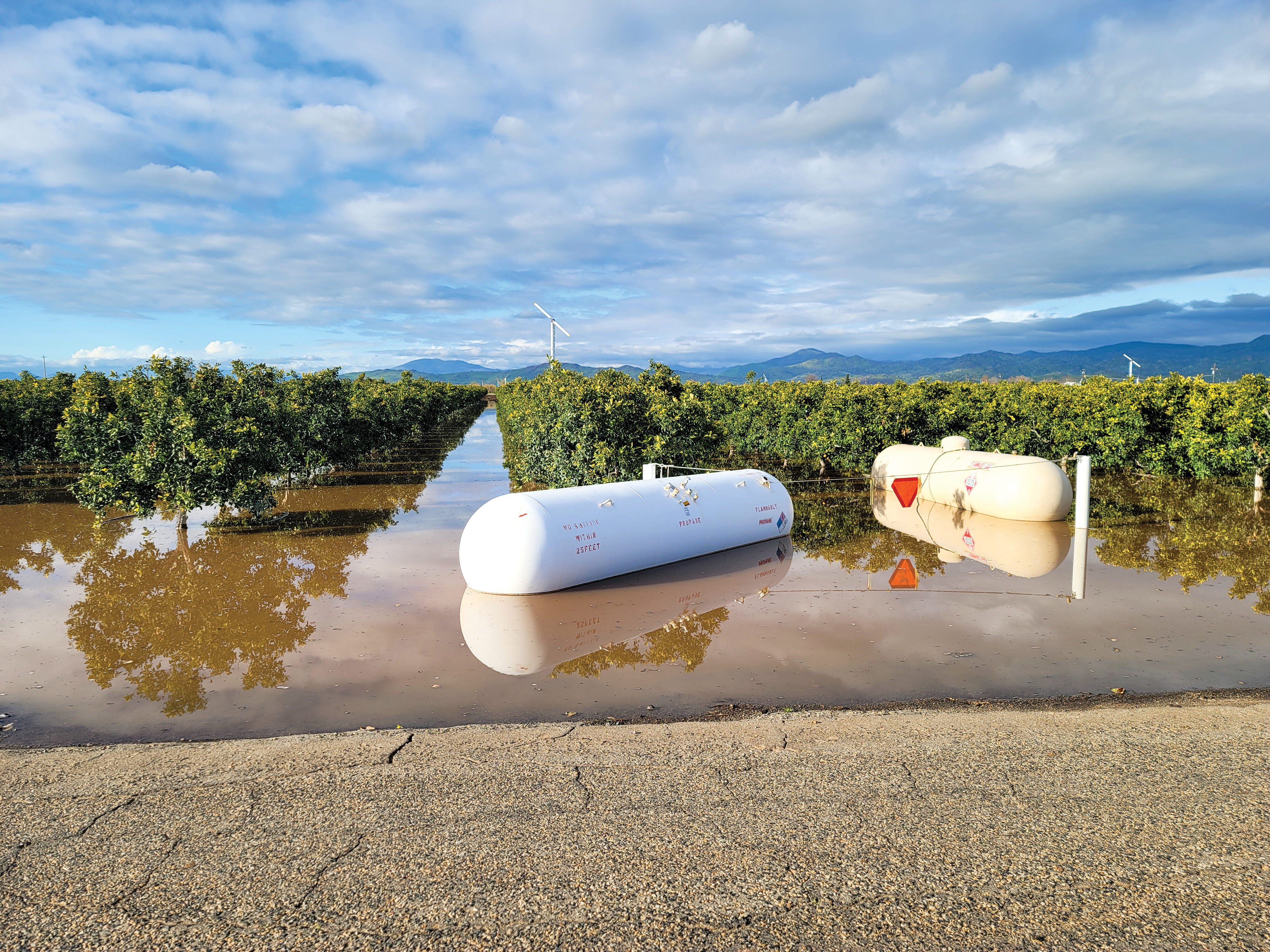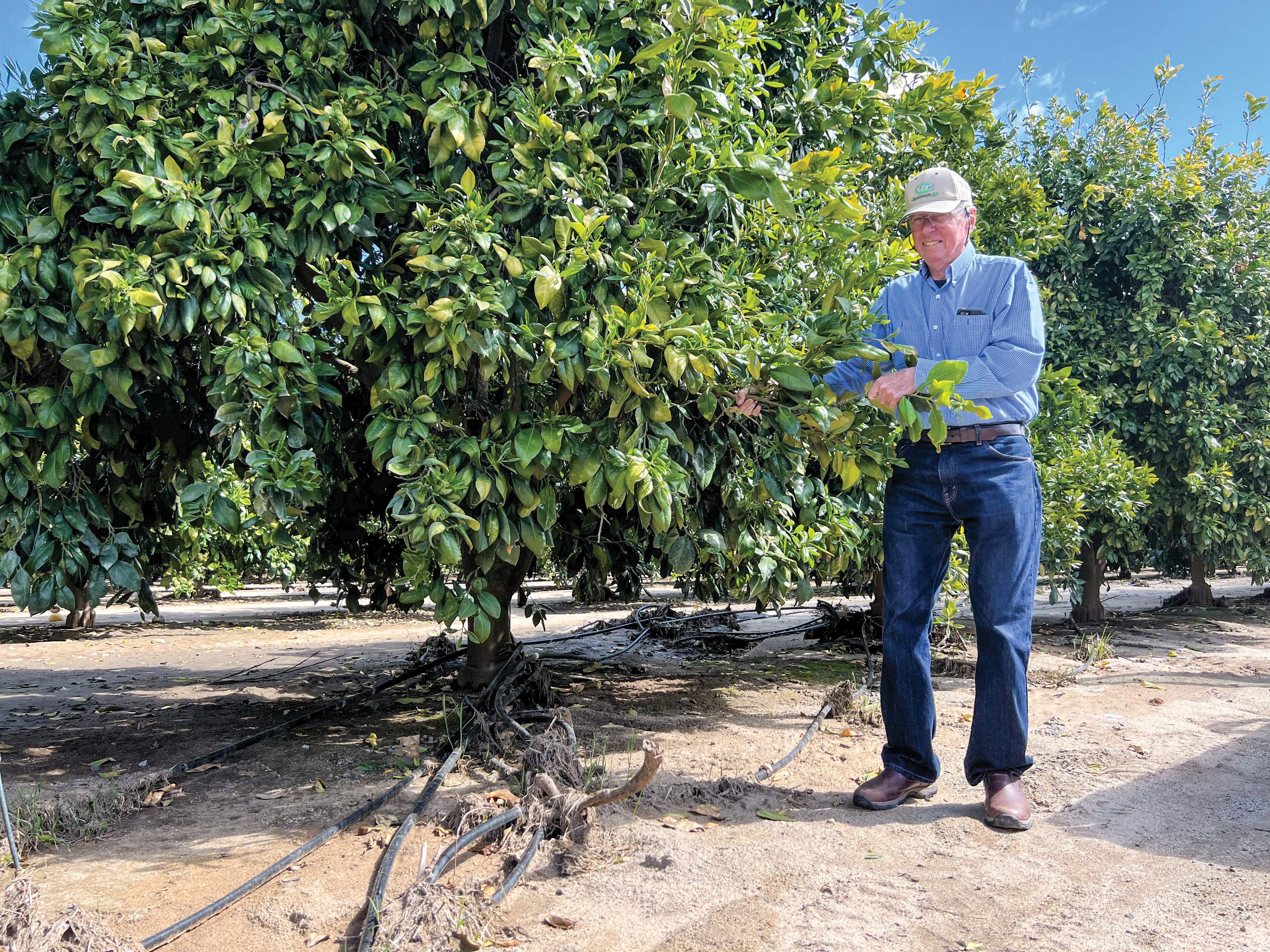Tulare citrus farmers battle mud, debris

Photo/Matt McEwen
Farmers in the state's top citrus-growing region are undergoing cleanup during harvest.

Photo/Matt McEwen
Mud and debris engulf an orchard in the Tulare County community of Exeter. Farmers in the state’s top citrus-growing region are undergoing cleanup during harvest. While more than 60% of the crop has been harvested, storms have disrupted some exports.

Propane tanks float in an Exeter citrus grove after levees breached in mid-March.

Tulare County farmer Bob Ward is shown on his farm, which suffered damages estimated at $100,000.
By Lisa McEwen
Growers in Tulare County normally would be enjoying harvest and fragrant orange blossoms this time of year. But last month’s flooding is requiring an extensive cleanup operation and is a major challenge for the state’s top citrus-growing region.
Flooding from multiple levee breaks in the east county Yokohl Creek carried away newly planted trees, ripped out irrigation systems, washed away valuable topsoil and scattered debris across the farming landscape.
Tulare County produces California’s largest share of navel and Valencia oranges and mandarins. Now farmers there are dealing with standing water in groves, mucky sediment several inches deep and chunks of driftwood strewn across their ranches.
They continue shoring up banks and levees while, farther west, farmers and communities are faced with the resurgence of Tulare Lake.
The weather whiplash from prolonged drought to flooding took Exeter farmer Bob Ward and many of his neighbors by surprise.
“We weren’t prepared for this much water,” said Ward, whose family operation farms 500 acres of pistachios, olives and citrus. Near his home, water was flowing 6 inches deep in every row. “We were prepared for another dry year.”
A ponding basin he constructed was no match for the historic flow of water. “The water ran right over it. Who would have thought we would ever have to deal with this?” he said.
A 10-acre block ready for a spring planting will need to be re-leveled before a replacement irrigation system can be installed. “We’ll basically have to start over on this one,” he said.
Like many colleagues, Ward plans to seek disaster assistance from a variety of U.S. Department of Agriculture programs. Farmers are reporting damages to the county agricultural commissioner and assessing overall impacts for the citrus sector.
Ward estimated that 150 acres on his farm suffered damages, saying he anticipates a minimum $100,000 of repairs to irrigation systems, tree replacement and eroded farm roads. Cleanup will require manual labor, with workers using rakes to remove woody debris and silt from tree trunks while pulling irrigation hoses and emitters back into place in preparation for spring farming tasks such as topping, hedging, spraying and irrigating.
More than 60% of the state’s citrus crop is picked, according to Casey Creamer, president of California Citrus Mutual. But the wet weather has hampered harvest across the industry, and export windows have been missed.
“It’s been a little bit of an up and down roller coaster,” Creamer said as he described the season thus far. “The wet weather has caused a lot of problems, but we don’t like to complain about rain and snowpack because we’ve been praying for that. There have been some missed opportunities for export markets because it has been difficult to get into certain fields.”
Localized impacts will be felt for months, but Creamer stressed that shoppers won’t notice much difference in grocery stores.
“Our packinghouses are good at picking the right blocks at the right time and have systems in place to keep a steady supply of fruit,” he said. “I don’t expect the average consumer will see much difference based on rain and flooding.”
Christina Saenger has been managing her family’s 340 acres for the past two years in the Exeter area. She is now delaying plans for a sinking basin for aquifer recharge to pay for repairing flood damage.
“I don’t know yet how much all of this is going to cost, and I’ve tightened my belt a little bit,” she said. “Picking has been delayed because it’s just still too mucky, and the equipment can’t get in. Our biggest thing is we’re going to have some costs just trying to rebuild roads and clean up the debris.”
Rain and muddy groves have delayed a second application of fungicide, which is causing fruit drop in some orchards. Farmers are seeing premature rot and a decline in fruit quality from hail damage.
Other concerns, especially those with trees in standing water, include water-borne diseases such as Phytophthora and root rot. Poor fruit set for the upcoming season is another potential lingering issue.
One bright side for farm manager Milo Gorden has been a long stretch of cold weather. “It has been wet, but it has also been cold, and that has helped with fruit quality,” he said. “If it had been warm and wet, our quality would be absolute crap.”
Gorden, who manages 1,200 acres of mostly citrus in Exeter and Lemon Cove for family and clients, anticipates farmers compensating for nutrients leached from fields due to the rains.
“One of the issues I will see this spring is spending extra money on fertilizer right off the bat, because nitrogen and potassium are highly leachable,” he said. “We need to replace those nutrients.”
As fruit begins to set this month, Gorden pointed to other concerns for citrus growers: rising costs of fertilizer, chemicals, labor, fuel and insurance.
“That’s probably my biggest concern right now, how costs are increasing. We’re just getting squeezed and squeezed,” he said.
Creamer said the cost to grow citrus has increased in the past two years from $3,300 to $5,000 an acre, “a huge increase in just a couple of years.”
Looming over the shoulders of many farmers is a monster snowpack, which could bring more flooding along uncontrolled waterways such as Yokohl Creek and other drainages. On April 1, the California Department of Water Resources said the snowpack is one of the largest on record. In the southern Sierra region, it is 300% of average.
The possibility of more flooding means Saenger is looking at her properties more closely and deepening sloughs that naturally run through ranches. “We are anticipating more water, thinking about the next runoff and where all that water is going to go,” she said. “But I am also going to try to sink some of this, too” to enhance groundwater supplies.
Ward has been farming since 1957 and said the past year is one of the toughest he’s been through.
“Just about everything that could go wrong this year has, between the damage we’ve incurred from the drought and now trees with very little bloom because we just had a big crop of small oranges.”
Despite the setbacks, Ward said he remains hopeful.
“We’ve got water,” he said. “That’s a big one.”
(Lisa McEwen is a reporter based in Tulare County. She may be contacted at mcewenlisamarie@gmail.com.)




